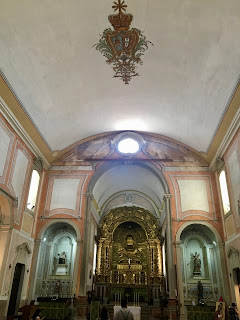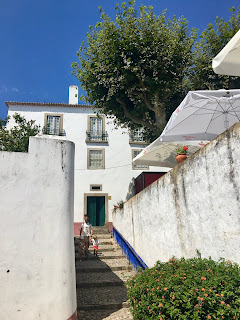We are invited to spend a day with Donna's cousin, José Miguel, at his home in Bombarral. It's just over half an hour north of Lisbon on the A8. He suggests a trip to the walled town of Óbidos, another town over, and the former home of many of the Queens of Portugal. As we drive out of Lisbon, past the outer towns of Odivelas and Loures, the urban fabric dissolves, and we are left with rolling hills, pear orchards, and vineyards, looking much like the North Bay of San Francisco.
Óbidos is set on a small peak in a wide valley. With our view on the highway, the towers are clear, and the layout of the town appears to be a simple, white stroke across the crest of the hill, surrounded by green cultivated lowlands. From the highway, we turn toward a series of dusty parking areas and leave the car. We pass a small, ruined aqueduct and fountain, set in a breezy open area where horse-drawn carts await passengers. We enter through a tower gate, suddenly dark, then find ourselves at a fork between two stone roads, with a cramped, crowded praça – one road leads down to the right, and one on-level to the left. Both paths are filled with people moving slowly, taking lots of selfies. We go left.
We get glimpses of the fields beyond through the breaks in the streetscape, whitewashed and trimmed in shocking blue and ochre yellow. The tiny but tidy old buildings are filled with souvenir shops and ginjinha stalls, serving chocolate cups with sour cherry liqueur. The crowds inch their way in and out, children stumble around with cold soda cans, drinking through straws.
The road widens and breaks downhill, not quite a square, and there is a bell tower and a church, the Igreja Paroquial São Pedro. Inside, the church is roomy, bright, and clean, with gold-toned poly-chrome and a splashy altar piece. Opposite the church is, apparently, a crypt – dark, modestly unlit, with some very nice stonework.
We begin our slow amble uphill to the castelo, the roads edged in flowers, and the battlements and orchards continue to go in and out of view. There are moments when the road seems to split open to a vista, fork uphill and down, then the view closes again and the road returns to its blue and yellow cadence.
Our destination comes into view as we leave the Praça de Santa Maria. Flowering trees mark the way, and the breeze returns as we near the top. Imposing and protected, the Castelo de Óbidos is now a Pousada, one of a group of unique, Portuguese boutique hotels. From the parapet, there are outstanding views to the village and the surrounding farms.
Behind the Castelo is a re-created medieval market, though currently empty. It's a bit Disney-esque. A large Shakespearean theater is on the other side. At the far end of the seating area is a narrow, steep stone stair, with no railing. We pass a series of serious-looking warning signs and ascend to the tower, for the breath-taking views around. José Miguel tells me that the tidal inlet used to reach the base of the fortress, and that the formal "royal" approach was by boat, past a small church – the Queen and her party would be blessed upon arrival and before departure from that church. The church is now a stone ruin at the edge of a farm plot. Looking out, it's hard to imagine the whole area flooded by seawater – and we both remark that it may yet happen again, if the climate scientists are right. And we feel bad for the farmers.






























No comments:
Post a Comment